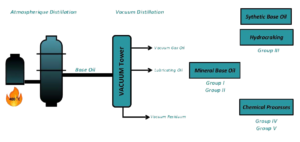Base Oil Groups
Generally, 2% of total Crude Oil Consumption globally is used to make the primary material of Lubricants also called Base Oil.
All lubricants consist of base oil. Normally, lubricants consist of 90% base oil and 10% additives. To get from crude oil to base oils, there are however a few steps to take.

Base Oil Manufacturing and Groups Explanation
Base Oils can be segmented into 2 main groups, according to the used treatments:
- Mineral Base Oils, group I and II, are base oils refined from crude oil. Actually cracking heavy, high-sulfur molecules of the oils into better quality, low-sulfur molecules under high temperature and pressure.

- Synthetic Base Oils, group III, which are mineral base oils refined through hydrocracking, and group IV and V, which are oils purely generated by synthetic or chemical processes. Produce by certain chemical processes that make them perform better performance to their consistent molecular structure and purity. Because of the consistent size and shape of the molecules and the adherence between them, there will be less friction between the metal surfaces and a significant overall better performance.

The American Petroleum Institute (or API) has categorized the different types of base oils into five distinctive groups. Understanding these class distinctions will prove essential when conducting business with base oil suppliers to choose the right product.
The characteristics of Base Oils:
- Pour point
- Viscosity and viscosity index
- Purity
- Volatility
- Thermal stability
- Hydrolytic stability (water resistance)
- Oxidation
- Sulfur and saturate content
| Group | Manufacturing Process | Saturate Level | Sulfur Level | Viscosity Index |
| Group I | Solvent Refining | < 90% | > 0.03% | 80 – 120 |
| Group II | Hydro – Processing ( Hydrocracking) |
≥ 90% | ≤ 0.03% | 80 – 120 |
| Group III | Severe Hydeocracking ( Catalytic De-Waxing) |
≥ 90% | ≤ 0.03% | ≥ 120 |
| Group IV | Chemical Reactions ( Synthesizing) |
100 % Poly – Alpha – Olefins | ||
| Group V | As Indicated | All others not included | ||
Group I
The least refined type produced by Solvent Refining. Oils are solvent-refined ( which is a simpler refining process) making them the least refined and therefore also the cheapest base oils available.
Group II
Similar to Group I base oils, Group II base oils are considered to be mineral oils. The better grade of petroleum base oil, which may be partially produced by Hydrocracking. All impurities will be removed from the oil leading to a clearer color.
Group III
The High quality grade of mineral base oil is Group III because they are fully produced by Hydrocracking, which makes the base oils purer.
Group IV
Not similar to the first three base oil categories (which are all mineral oils). Include of synthetic oils made of Poly-alpha-olefins PAO. Poly-alpha-olefins PAO oils are much more stable in extreme temperatures (Very cold and very hot temperatures).
Group V
Another type of Base Oils which are not in other groups.
